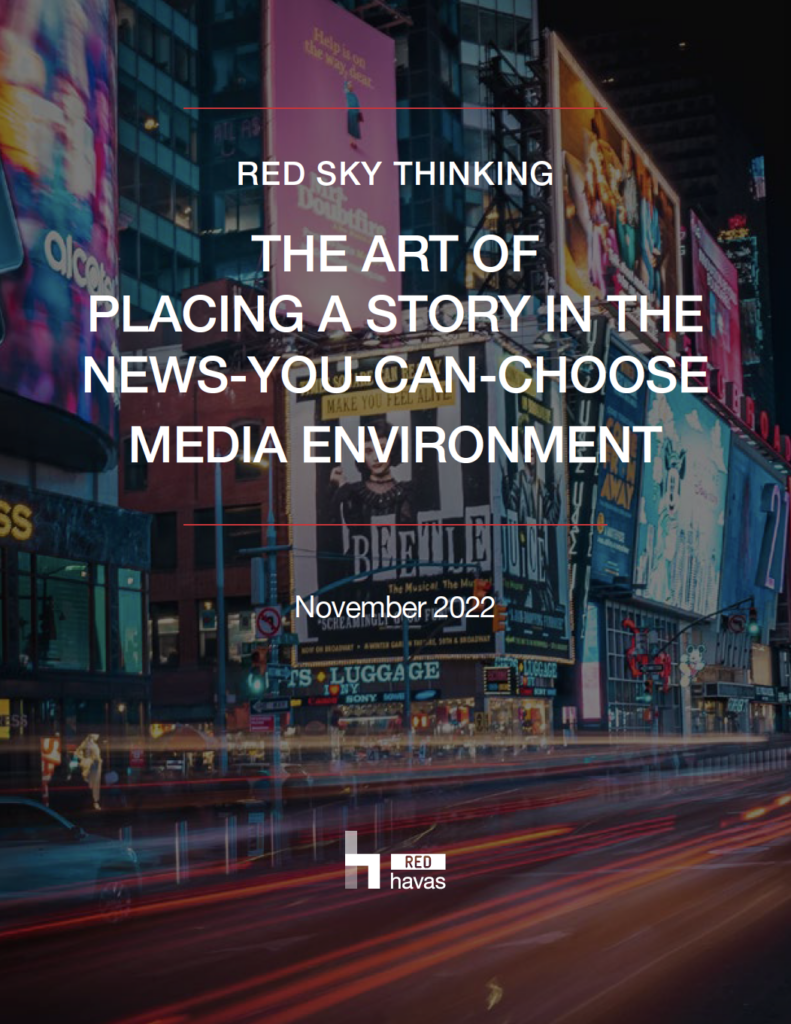People must now filter through an avalanche of news and content every day. So, what does it take for a brand to place a story that breaks through?
For our new white paper, we asked this of Redsters, including Ellen Mallernee Barnes, Linda Descano, Jodi Einhorn, Sharon Nieuwenhuis, Lesley Sillaman and Pattie Sullivan, as well as PR consultants Cynthia Challener and Beth Willers, journalist Dominik Lemanski, and Christopher Wink, cofounder and CEO of the news organization Technical.ly.
Our research uncovered three major trends shaping the new channels, choices and definitions of journalism:
- The avalanche of content that people must filter through
- Consumers’ deepening distrust and apathy toward the news media
- The changing business of news
This is now a news-you-can-choose environment
We don’t have, nor do we want, a one-size-fits-all news source anymore. Instead, the mix of news people choose to consume is as unique as they are.
When it comes to placing meaningful news stories in this post-pandemic media landscape, brands face sizeable but not insurmountable obstacles.
Some editors and journalists receive thousands of emails a day. Under tremendous deadline pressure in this 24/7/365 news cycle, they’re short on time and prefer to digest information in a specific way. To earn a reply from an editor or reporter working within this paradigm, a brand’s story needs to be deftly told, personally and culturally relevant, and deliver a value add to readers.
Three tactics in particular have helped us be successful in getting our clients’ stories to break through:
- Lead with your brand’s impact, not your marketing information
Your brand’s impact on people should be at the heart of every story you tell. Not the product you’re trying to sell, company you want to raise awareness of, or message you want to land. It’s about the human beings your company has impacted. Who are they, and what’s been the benefit to them?
Red Havas has made a case for person-to-person (P2P) communications, as opposed to the more traditional stay-in-your-lane practices of business-to-business (B2B) or business-to-consumer (B2C) communications.
- Personalize and contextualize every pitch and interaction with media
There has to be a good reason why a journalist would talk to your company spokesperson over any others. Can you supply facts that show that you’re the best, first, latest or most unique? Are you finding out something that counters a common trend? Even better.
To succeed, your brand needs to showcase it has real credentials. Working with a PR firm that knows how to spark a connection with the right journalist and what they’re pitching on your behalf — ensuring it is both personally relevant to that media contact and culturally relevant to what’s going on in the news cycle — can put your brand in position to stand out.
- Get to the point with pithy pitches and press releases.
We must contend with shorter attention spans. This shows up both in how consumers take in content and how the media interacts with our pitches. Successful pitches consider what each journalist likes to cover, how they like to receive information and how they like to be spoken to.
Download the News-You-Can-Choose white paper for insights about how to make journalists’ jobs easier for them and much more.
